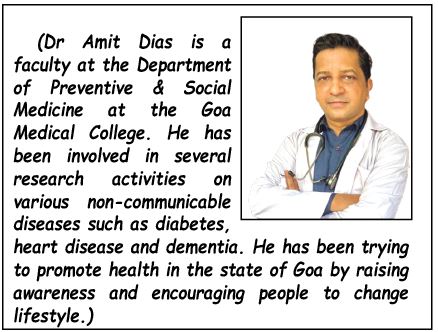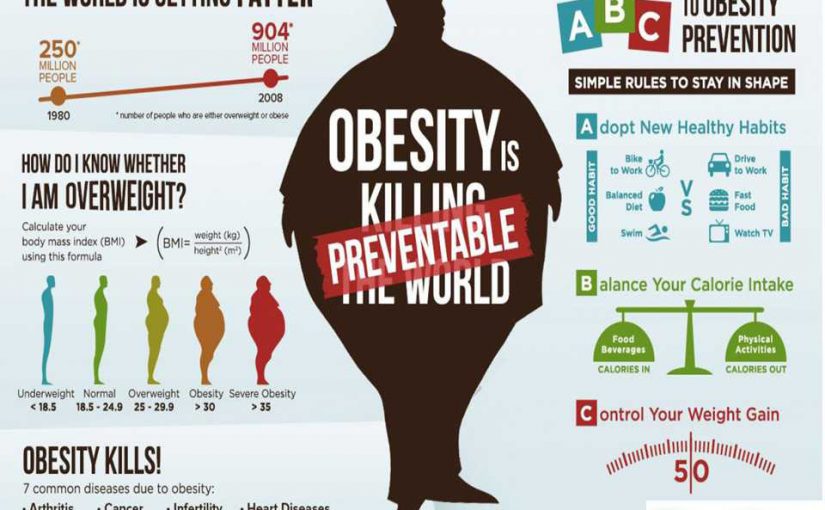World Anti-Obesity Day Special!
On the occasion of World Anti-Obesity Day on November 26 we got a chance to speak to DR AMIT DIAS from the Department of Preventive & Social Medicine at the Goa Medical College & Hospital. We got some very interesting information and tips on how to check for obesity and fight it. “We need to literally stand up against obesity,” he explains, “Sitting is a risk factor for several diseases and may be slowly killing you. Obesity is a growing into an epidemic.”
Read this informative interview on weight and the ABC to weight loss.
Goan Observer: Doctor, let’s start with the very basic – what exactly is obesity?
Dr Amit Dias: Obesity is a medical condition characterized by the accumulation of excessive body fat, to the extent that it may have adverse effects on health. It’s not just about appearance; obesity is associated with a range of serious health problems internally. We can use measures such things as the BMI or waist circumference to objectively check if we are overweight or obese. We should not wait to lose weight. Start now and stay in shape.
Q: Are there any simple tips to stay in shape?
A: Make note of the ABC for staying in shape:
A- Adopt healthy habits: Exercise instead of screen time with the mobile and television, eat healthy items such as fruits and vegetables, and a balanced diet instead of fast food with saturated and trans fats. Use a cycle or walk wherever possible. Stand instead of sitting as by standing alone one can lose 50 calories in an hour. Sitting is a major risk factor for obesity.
B- Balance your calorie intake: Measure your consumption and eat appropriate to your activity and metabolism. If you have a calorie deficit, you will start losing weight.
C- Control your weight gain: Monitor your weight, BMI and waist circumference and keep it under control. These are simple measures that can be done at home. In general if you cut around 500 calories per day, you can lose around 1/2 to one pound in a week. But this can vary from person to person.
Cutting calories should be done carefully and not at the cost of essential nutrition. Skip high calories with low-nutrition items. Swap high-calorie foods with low-calorie choices and cut portion sizes. To start with, know that sweet and fatty food has high calories. Avoid saturated and trans fats.
Q: You mentioned about saturated and trans fats. Can you simplify this for our readers and what are their health risks?
A: Yes, excess fat in your diet, especially saturated fats, can raise your cholesterol and triglycerides which increases the risk of heart disease. The advice is to cut down on all fats and replace saturated fat with some unsaturated fat.
Saturated fats are found in many foods, both sweet and savory. Most of them come from animal sources, including meat and dairy products, as well as some plant foods, such as palm oil and coconut oil. Butter, meat, cheese, cream, biscuits, pastries, etc, are high in saturated fats.
Cholesterol, which you would have heard of, is a fatty substance that’s mostly made by the body in the liver and carried in the blood by low-density lipoprotein (LDL, bad cholesterol) and high-density lipoprotein (HDL, good cholesterol).
Eating too much-saturated fats in your diet can raise bad-cholesterol in your blood, which can increase the risk of heart disease and stroke. Good-cholesterol
has a positive effect by taking cholesterol from parts of the body where there’s too much of it to the liver, where it’s disposed of.
We need fats! They give energy and also fat-soluble vitamins such as vitamins A, D, E, and K.
Trans fats are found naturally at low levels in some foods, such as meat and dairy products. They can also be found in partially hydrogenated vegetable oil. Hydrogenated vegetable oil must be declared on a food’s ingredients list if it’s been included. It’s mandatory to report the amount of trans fats in any food item. Adults may not have more than 5 gm of trans fats per day. One must make it a habit to read food labels, however fine the print may be.
If you want to reduce your risk of cardiovascular disease, then exchange saturated fats for unsaturated fats.
Q: That’s interesting, how do we measure and monitor obesity, you mentioned about BMI, how is it calculated?
A: There are various methods to measure obesity, but the most commonly used is the Body Mass Index (BMI). BMI is calculated by dividing a person’s weight in kilograms by the square of their height in meters. According to the WHO, a BMI of ≥ 25 is overweight ≥ 30 is generally classified as obese. In India however a BMI≥ 23 is considered overweight and ≥ 25 is considered obese, as we are at a higher risk of developing non-communicable diseases.
Though widely used, BMI is not the best indicator for all people. If someone is muscular for example, they will have a higher weight due to the muscle mass and can wrongly have a higher BMI, without being obese.
Q: So is there any other measure of obesity?
A: Yes, we can consider waist circumference and the waist-hip ratio. Waist circumference reflects abdominal fat, which is particularly linked to health risks. You might be familiar with the analogy of the apple and pear-shaped body. For men, a waist circumference above 102 cm and for women, above 88 cm, indicates an increased risk. However, for Indian men and women, the cut-off is 94 cm and 80 cm, respectively.
Waist-hip ratio is another measure where a higher ratio indicates a higher risk of health issues. The cut-offs are 0.9 for men and 0.85 for women. The apple shape-extra weight around the abdomen is riskier than the pear shape-extra weight around the hips and thighs.
Q: Speaking of risks, what is the current global and regional prevalence of obesity, both among adults and children?
A: The world is getting fatter. According to an estimate by the World Health Organization, around 39% of adults ≥18 years were overweight, and 13% were obese. In children, the prevalence of obesity is also alarming, with over 340 million children and adolescents aged 5-19 being overweight or obese worldwide.
In India, the prevalence of obesity is rising rapidly, particularly in urban areas. This is a significant concern, as obesity is not only a health issue but also places a considerable economic burden on healthcare systems. In a study we conducted in rural schools, we also found an increasing trend in obese children which is disturbing. Obesity is a risk factor for several non-communicable diseases including heart attacks, Alzheimer’s disease and cancer. It significantly contributes to morbidity as well as mortality.
Q: What is your advice to our readers?
A: We need to eat to live and not live to eat. Watch your plate and what you eat. In our recent research in Goa on diabetes (the ICMR- INDIAB study), we realized that Goa has the highest prevalence of diabetes in the country. The obesity and diabetes epidemic are related as obesity increases insulin resistance and leads to type 2 diabetes. We need to make active efforts to change our lifestyle. Do not body shame people who are overweight, support them in their efforts to lose weight. Watch your weight and stay healthy.

